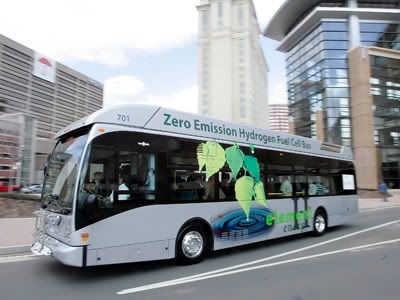Hydrogen powered vehicles can convert hydrogen into mechanical energy in two ways, through combusting the fuel to create power at the wheels or converting the hydrogen to electricity through a fuel cell, which sends the power to an electric motor. So while technically, you don’t need to plug in a fuel cell electric vehicle, it is still very much an electric car. I actually had the chance to ride in a fuel cell electric SUV at the Seoul Metropolitan Government last summer. These vehicles show promise as a compliment or substitute for traditional electric drivetrains, since hydrogen fuel can be transported with minimal energy loss, and they allow for quick refueling. However, the technology is still very, very expensive compared to plug-in electric vehicles.

Cleveland has not been known for much since Lebron James left, but in the past year, the city’s Regional Transit Authority has been partnering with NASA Glenn Research Center to develop a hydrogen powered fuel cell bus fleet. This technology provides a great opportunity for Cleveland to showcase their commitment to sustainable, clean transportation. However, right now, each bus costs $2 million dollars, in addition to the hydrogen fueling infrastructure requirements.
INDUSTRY NEWS
Cleveland RTA launches hydrogen buses
Metro Magazine
January 16, 2013
The Greater Cleveland Regional Transit Authority (RTA), in coordination with NASA Glenn Research Center, launched a hydrogen bus project in Cleveland.
Customers on various routes may now experience a quieter and greener ride, powered by hydrogen, not diesel. This vehicle began carrying customers in January 2013.
RTA is the first transit system in Ohio — and one of the few in the nation — to produce its own hydrogen fuel using electrolysis, a process that separates water into hydrogen and oxygen.
The 40-foot bus has a capacity of 57 passengers and will be in service between six and eight hours daily on various RTA routes. The bus operates with nearly twice the fuel-efficiency as diesel-fueled bus; and is much quieter as well. The joint project between RTA and Glenn supports the development of new technologies and clean and renewable energy sources.
The hydrogen-fueled bus is on loan from United Technologies Corp. (UTC Power) and the electrolyzer is on loan from NASA Glenn. The entire program, which includes the fueling system and bus, is valued at $3 million. RTA Board members approved a $50,000 investment in this project, which pays for the installation and use of fueling equipment.
This goal of this collaboration between RTA and NASA Glenn is demonstrating the safety, fuel-efficiency, economy and reliability of hydrogen production and fueling using electrolysis. The fuel cell bus is powered by hydrogen and does not produce harmful emissions — the only emission is water vapor.
Link:
http://www.metro-magazine.com/news/story/2013/01/cleveland-rta-launches-hydrogen-buses.aspx?ref=Express-Thursday-20130117&utm_source=Email&utm_medium=Enewsletter


















